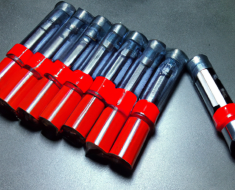“Precision and power, engineered for safety.”
Ballistics of Frangible Ammunition
Frangible ammunition is a type of bullet that is designed to break apart upon impact with a hard surface, such as steel or concrete. This unique characteristic makes frangible ammunition ideal for use in situations where overpenetration is a concern, such as in crowded urban environments or indoor shooting ranges. But what exactly makes frangible ammunition different from traditional bullets, and how does it work?
To understand the science behind frangible ammunition, we first need to look at the ballistics of these specialized bullets. Frangible bullets are typically made from a mixture of copper and tin powder that is compressed into a solid form. When the bullet strikes a hard surface, such as a steel target or concrete wall, the force of impact causes the bullet to shatter into small fragments. This fragmentation reduces the risk of ricochets and overpenetration, making frangible ammunition safer to use in close quarters.
The key to the effectiveness of frangible ammunition lies in its composition and design. Unlike traditional bullets, which are made from solid lead or copper jackets, frangible bullets are designed to break apart upon impact. This unique construction allows the bullet to transfer its energy more efficiently to the target, increasing stopping power while reducing the risk of collateral damage.
In addition to their unique composition, frangible bullets are also designed to fragment in a controlled manner. This means that the bullet will break apart into small, uniform pieces upon impact, rather than splintering into unpredictable shards. This controlled fragmentation helps to maximize the bullet’s energy transfer to the target while minimizing the risk of injury to bystanders.
The science behind frangible ammunition also extends to its terminal ballistics. When a frangible bullet strikes a soft target, such as ballistic gelatin or tissue, it behaves differently than traditional bullets. Instead of expanding or deforming upon impact, frangible bullets tend to break apart into smaller fragments that penetrate deeply into the target. This unique behavior can cause more damage to vital organs and tissues, making frangible bullets an effective choice for self-defense and law enforcement applications.
One of the key advantages of frangible ammunition is its reduced risk of overpenetration. Traditional bullets can pass through multiple layers of drywall or other barriers, posing a significant risk to bystanders. Frangible bullets, on the other hand, are designed to break apart upon impact with hard surfaces, reducing the risk of collateral damage. This makes frangible ammunition an ideal choice for use in crowded urban environments or other situations where bystander safety is a concern.
In conclusion, the science behind frangible ammunition is both fascinating and practical. By understanding how these specialized bullets work and why they are designed the way they are, we can better appreciate their unique benefits and applications. Whether used for self-defense, law enforcement, or training purposes, frangible ammunition offers a safe and effective alternative to traditional bullets. Its controlled fragmentation and reduced risk of overpenetration make it an ideal choice for situations where safety is paramount. So next time you’re at the range or considering your personal protection options, consider giving frangible ammunition a try – you might just be surprised by its performance and effectiveness.
Material Composition of Frangible Bullets
Frangible ammunition is a type of bullet that is designed to break apart upon impact with a target, reducing the risk of overpenetration and collateral damage. This unique characteristic makes frangible ammunition ideal for use in close-quarters environments such as indoor shooting ranges, where the risk of ricochets is high. But what exactly makes frangible ammunition different from traditional bullets? In this article, we will explore the science behind frangible ammunition, starting with the material composition of frangible bullets.

Frangible bullets are typically made from a mixture of copper and tin powder, along with other binding agents such as polymer or wax. This combination of materials gives frangible bullets their unique properties, allowing them to break apart upon impact without causing harm to the shooter or bystanders. The copper and tin powder provide the necessary density and hardness for the bullet to maintain its shape during flight, while the binding agents hold the powder together until it strikes a target.
When a frangible bullet hits a solid object, such as a steel plate or concrete wall, the force of impact causes the bullet to shatter into small fragments. This fragmentation disperses the energy of the bullet over a larger area, reducing the risk of overpenetration and minimizing the potential for collateral damage. Frangible bullets are designed to disintegrate upon impact with any hard surface, making them ideal for use in training scenarios where safety is paramount.
In addition to their material composition, frangible bullets are also engineered to fragment in a controlled manner to ensure consistent performance. The design of the bullet plays a crucial role in determining how it will break apart upon impact, with factors such as bullet shape, weight distribution, and velocity all influencing fragmentation patterns. By carefully calibrating these variables, manufacturers can create frangible bullets that reliably break apart upon impact without sacrificing accuracy or reliability.
One of the key advantages of frangible ammunition is its ability to reduce the risk of ricochets in shooting environments. Traditional bullets can bounce off hard surfaces at unpredictable angles, posing a danger to shooters and bystanders alike. Frangible bullets, on the other hand, are designed to break apart upon impact with any solid object, minimizing the risk of ricochets and ensuring that all energy is dissipated within the target area.
In conclusion, the material composition of frangible bullets plays a crucial role in determining their unique properties and performance characteristics. By combining copper and tin powder with binding agents such as polymer or wax, manufacturers can create frangible bullets that break apart upon impact with a target without causing harm to shooters or bystanders. The controlled fragmentation of frangible bullets ensures consistent performance and minimizes the risk of ricochets in shooting environments. Overall, frangible ammunition offers a safe and effective alternative to traditional bullets for use in close-quarters scenarios where safety is paramount.
Terminal Performance of Frangible Rounds
Frangible ammunition is a type of bullet that is designed to break apart upon impact, reducing the risk of overpenetration and collateral damage. This type of ammunition is commonly used in shooting ranges, training exercises, and self-defense situations. One of the key factors that sets frangible ammunition apart from traditional bullets is its terminal performance.
When a frangible round strikes a target, it breaks apart into smaller pieces, dispersing energy and reducing the risk of ricochets. This can be particularly important in indoor shooting ranges or crowded urban environments where overpenetration can pose a serious threat to bystanders. By fragmenting upon impact, frangible ammunition minimizes the risk of injury to innocent parties while still delivering effective stopping power.
The science behind frangible ammunition’s terminal performance lies in its composition. Frangible bullets are typically made from a mixture of copper and tin powder compressed into a solid projectile. When the bullet strikes a hard surface, such as steel or concrete, the force of impact causes the projectile to shatter into tiny fragments. These fragments lose their energy quickly, reducing the likelihood of ricochets and collateral damage.
In addition to reducing the risk of overpenetration, frangible ammunition also offers advantages in terms of terminal ballistics. Because frangible bullets break apart upon impact, they create a larger wound channel than traditional bullets. This can lead to more rapid incapacitation of an assailant, increasing the likelihood of a successful self-defense scenario.
Another factor that contributes to the terminal performance of frangible rounds is their ability to transfer energy more efficiently than traditional bullets. When a frangible bullet strikes a target, it transfers its kinetic energy to the surrounding tissue more effectively than a solid projectile. This can result in greater tissue damage and faster incapacitation of an assailant.
Frangible ammunition’s terminal performance is also influenced by factors such as velocity and bullet design. Frangible bullets are typically lighter than traditional projectiles, which can result in higher velocities and increased energy transfer upon impact. Additionally, some frangible rounds are designed with pre-fragmented cores or hollow points to enhance their terminal ballistics.
Overall, the science behind frangible ammunition’s terminal performance is based on its ability to break apart upon impact, reduce the risk of overpenetration, create larger wound channels, transfer energy efficiently, and incapacitate assailants quickly. These factors make frangible ammunition an attractive option for shooters who prioritize safety and effectiveness in self-defense situations.
In conclusion, frangible ammunition’s terminal performance is a result of its unique composition and design features. By breaking apart upon impact and transferring energy efficiently, frangible rounds offer advantages in terms of safety, stopping power, and terminal ballistics. Whether used for training exercises or self-defense scenarios, frangible ammunition provides shooters with a reliable and effective option for mitigating risks and achieving desired outcomes.
Environmental Impact of Frangible Ammunition
Frangible ammunition has gained popularity in recent years due to its unique properties and benefits. One of the key advantages of frangible ammunition is its reduced environmental impact compared to traditional ammunition.
Frangible ammunition is designed to break apart upon impact, reducing the risk of ricochets and collateral damage. This is especially important in indoor shooting ranges and urban environments where stray bullets can pose a serious threat to bystanders and property. By disintegrating upon impact, frangible ammunition minimizes the risk of lead contamination in the environment.
Lead is a toxic heavy metal that can have serious health consequences for humans and wildlife. When traditional ammunition is fired, lead particles can be dispersed into the air and soil, contaminating the surrounding environment. Frangible ammunition, on the other hand, is typically made from copper or other non-toxic materials that do not pose a risk of lead contamination.
In addition to reducing lead contamination, frangible ammunition also helps to minimize damage to shooting range infrastructure. Traditional bullets can penetrate steel targets and backstops, causing costly damage that requires frequent repairs. Frangible bullets break apart upon impact, reducing wear and tear on range equipment and extending its lifespan.
Furthermore, frangible ammunition is also more environmentally friendly in terms of manufacturing and disposal. The production of traditional ammunition involves mining, smelting, and refining processes that can have a significant impact on the environment. Frangible ammunition, which is often made from recycled materials, has a lower carbon footprint and reduces the demand for new resources.
When it comes to disposal, frangible bullets are less harmful to the environment compared to traditional bullets. Lead-containing ammunition can leach toxic metals into the soil and water when disposed of improperly. Frangible bullets, on the other hand, do not pose the same risk of environmental contamination and can be safely disposed of in landfills or recycling facilities.
Overall, frangible ammunition offers a more sustainable alternative to traditional ammunition by reducing lead contamination, minimizing damage to shooting range infrastructure, and lowering its environmental impact throughout its lifecycle. As awareness of environmental issues continues to grow, more shooters are turning to frangible ammunition as a responsible choice for both their safety and the planet.
In conclusion, the science behind frangible ammunition demonstrates its superior environmental performance compared to traditional ammunition. By choosing frangible bullets, shooters can help protect the environment while enjoying the benefits of reduced ricochets, improved safety, and lower maintenance costs. As technology continues to advance, frangible ammunition will likely become even more prevalent in shooting sports as shooters prioritize sustainability alongside performance.
Effectiveness in Self-Defense Situations
Frangible ammunition is a type of bullet that is designed to break apart upon impact, creating a reduced risk of over-penetration and minimizing the potential for collateral damage. This unique design makes frangible ammunition an excellent choice for self-defense situations where accuracy and precision are paramount.
The science behind frangible ammunition lies in its composition. These bullets are typically made from a combination of powdered metals, such as copper or tin, which are compressed under high pressure to form a solid projectile. When the bullet strikes a hard surface, such as a wall or metal target, the force of impact causes the bullet to break apart into small fragments, dispersing energy and reducing the risk of ricochets.
One of the key advantages of frangible ammunition in self-defense situations is its ability to deliver maximum stopping power while minimizing the risk of collateral damage. Traditional bullets can often pass through a target and continue traveling, posing a threat to bystanders or property. Frangible ammunition, on the other hand, is designed to fragment upon impact, effectively transferring all of its energy into the target and reducing the likelihood of penetration through walls or other barriers.
In addition to its reduced risk of over-penetration, frangible ammunition also offers superior accuracy and precision compared to traditional bullets. The fragmentation upon impact creates a larger wound cavity, increasing the likelihood of incapacitating an attacker with a single shot. This can be especially important in high-stress situations where split-second decisions can mean the difference between life and death.
Another benefit of frangible ammunition is its versatility across different types of firearms. Frangible bullets can be used in handguns, rifles, and shotguns, making them an ideal choice for individuals looking for a reliable self-defense option that can be easily adapted to their preferred firearm.
When considering frangible ammunition for self-defense purposes, it’s important to understand how it differs from traditional ammunition. While frangible bullets offer many advantages in terms of safety and precision, they may not be suitable for all situations. It’s essential to practice with frangible ammunition to become familiar with its performance characteristics and ensure that you can effectively use it in a self-defense scenario.
Overall, frangible ammunition offers a scientifically proven solution for individuals seeking an effective self-defense option that prioritizes safety and precision. By understanding the unique properties of frangible bullets and practicing with them regularly, you can enhance your ability to defend yourself and your loved ones in high-stress situations. Whether you’re a seasoned firearms enthusiast or new to self-defense tactics, frangible ammunition provides a reliable and effective solution for protecting yourself in today’s uncertain world.






